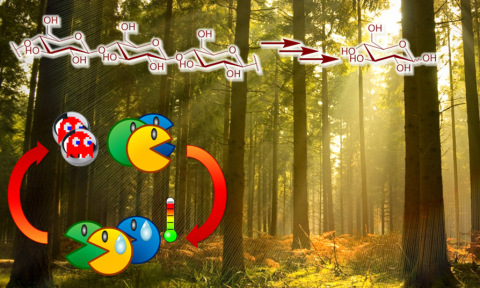Grinding enzymes to break down cellulose

Cellulose, one of the three major components of plants, is showing great promise as a renewable source for many convenience products. It is made of glucose, a molecule which can be fermented by microorganisms into virtually any desired small molecule of interest. More especially it can be converted to ethanol to make sustainable biofuels.
Cellulose is however hard to breakdown. It is made of long strands of glucose polymers which bind tightly together and intertwine with the other plant components: hemicellulose and lignin. Aggressive reagents and treatments are usually required to process this material leading to large energy consumption and waste production which eventually end up taking a toll on the environment. This is why cellulose is still widely considered as a waste.
Dr. Leigh Loots and Dr. F. Hammerer, working under the supervision of Prof. K. Auclair and Prof. T. Friščić at McGill Chemistry Department recently discovered a method that could make cellulose digestion a much easier process. They observed that the highly diluted solutions in which researchers have been using enzyme produced by fungi growing on wood was remote from their natural environment. They mimicked this environment by reducing the amount of water to a bare minimum and observed improved enzyme activity compared to comparable in-solution processes.
The breakthrough came from the use of mechanochemical techniques like ball-milling and accelerated aging. The former makes use of physical impacts from steel balls on reagents to push chemical reactions forward while the latter consists in a static incubation in humid conditions at 40-60°C. Combining both approaches, Auclair and Friščić invented Reactive Aging (or RAging) which allowed efficient conversion of cellulose cleanly into glucose in only a few hours without the need for any harsh chemicals or high temperature.
The technique has been filed for patenting and is at the center of a collaboration with Green Centre Canada.
Beyond applications to waste management, this approach also questions basic knowledge about enzymes which are usually thought of as delicate entities requiring dilute conditions for optimal activity. The work by Auclair and Friščić demonstrates that in the absence of bulk solvent enzymes are able to withstand and to strive under mechanical stress.
Highlights and Press releases appeared in the magazines of Chemistry Institute of Canada and the online outlet "In the pipeline" of Science publishing group.